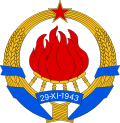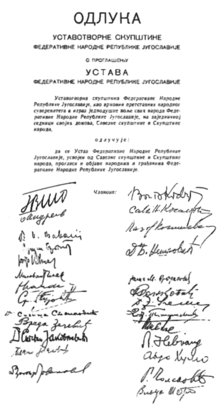- Constitution of the Socialist Federal Republic of Yugoslavia
-
Yugoslavia 
This article is part of the series:
Politics and government of
YugoslaviaExecutiveParliamentElectionsConstitutionStates
The Constitution of the Socialist Federal Republic of Yugoslavia (SFRY) was the supreme law of S.F.R. Yugoslavia and its predecessor, the Federal People's Republic of Yugoslavia (FPRY).
Contents
Federal constitutions
This federal constitution was revised several times since first being drafted after World War II. These revisions were as follows:
- Constitution of FPRY, adopted on January 31, 1946
- Constitutional Law of the FPRY, adopted on January 13, 1953
- Constitution of SFRY, adopted on April 7, 1963
- Constitution of SFRY, adopted on February 21, 1974
1946 Constitution
Tito's first constitution (1946) was modeled on the Soviet constitution. This constitution included direct Communist Party control over all aspects of state activity, no recognition of the constituent republics as political entities, and no stipulation of individual civil liberties.[1]
1953 Constitution
The Sixth Communist Party Congress (1952) was a watershed of Yugoslav political change, driven primarily by the need to prove that Yugoslavia could create a form of socialism superior to the Stalinist version from which it had recently split. In that meeting, liberal forces led by Milovan Djilas (a long-time close adviser of Tito) created a constitution that partially separated party and state political functions and restored some political rights to the constituent republics and some civil rights to individuals. At that time, constitutional foundations were also built for workers' control over enterprises and expanded local government power. The Federal People's Assembly established by the 1953 constitution contained two houses--a Federal Chamber, directly representing the regions, and a Chamber of Producers, representing economic enterprises and worker groups. The federal government executive branch (the Federal Executive Council, FEC) included only the five ministries dealing with national affairs and foreign policy. Foreign policy became the most important function of the FEC. The Communist Party retained exclusive political control, based on the Leninist credo that the state bureaucracy would wither away, and that a multiparty system would only bring more cumbersome bureaucratic institutions.[1]
Through the remainder of the 1950s, the economic decentralization of the 1953 constitution increased friction among the republics, which sought advantages in national allocation and resource redistribution policy. By 1960 this friction generated a new wave of constitutional change, aimed at preserving regional autonomy while restoring economic policy decisions to the federal level.[1]
1963 Constitution
The regional divisions that prompted constitutional change also delayed concrete action by two years, as the constitution's framers sought language satisfactory to all political factions. By 1963 a new constitution had been prepared under the guidance of Eduard Kardelj, Tito's chief theoretician, with substantial input from liberal legal scholars. The new document reflected the perceived need for recentralization: the parliamentary Federal Assembly (Skupstina) was divided into one general chamber, the Federal Chamber, and four chambers given specific bureaucratic responsibilities. In an effort to end regional conflict and promote national representation of the Yugoslav people, the constitution directed that individual republics be represented only in the Chamber of Nationalities, a part of the Federal Chamber. This provision was especially important in ensuring continued contributions from all regions to federal development funds for the poorer republics.[2]
Other provisions of the new constitution increased decentralization instead of reducing it. Tito retained his position as president of the federation but renounced his state position as president of the Federal Executive Council, a change that further separated party and state functions. The 1963 constitution also introduced the concept of rotation, which prohibited the holding of higher or lower level executive positions for more than two four-year terms. Other notable provisions extended human and civil rights and established constitutionally guaranteed court procedures. All these provisions were unique among the constitutional systems of contemporaneous communist states.[2]
1974 Constitution
The 1974 Constitution, which remained in effect through the end of the 1980s, only partially reversed the extreme decentralization of the early 1970s. With 406 original articles, it was one of the longest constitutions in the world. It added elaborate language protecting the self-management system from state interference and expanding representation of republics and provinces in all electoral and policy forums. The Constitution called the restructured Federal Assembly the highest expression of the self-management system. Accordingly, it prescribed a complex electoral procedure for that body, beginning with the local labor and political organizations. Those bodies were to elect communelevel assemblies, which then would elect assemblies at province and republic level; finally, the latter groups would elect the members of the two equal components of the Federal Assembly, the Federal Chamber and the Chamber of Republics and Provinces. Like its predecessor, the 1974 Constitution tried to refine the balance between economic and ethnic diversity on one hand, and the communist ideal of social unity on the other.[3]
The new Constitution also reduced the State Presidency from twenty-three to nine members, with equal representation for each republic and province and an ex-officio position for the president of the League of Communists. The party tried to reactivate its role in guiding national policy through automatic inclusion of the party chief in the State Presidency. That practice was discontinued in 1988, when the political climate called for further separation of party and state functions. This reduced the State Presidency to eight members. The 1974 Constitution also expanded protection of individual rights and court procedures, with the all-purpose caveat that no citizen could use those freedoms to disrupt the prescribed social system. Finally, Kosovo and Vojvodina, the two constituent provinces of Serbia, received substantially increased autonomy, including de facto veto power in the Serbian parliament. This change became a turbulent issue of inter-republican debate in post-Tito Yugoslavia.[3]
The consitution also proclaimed Marshal Josip Broz Tito president for life.
Provincial constitutions
The constitutional system of the former Yugoslavia consisted of the federal constitution and the constitutions of its republics and autonomous provinces. At first only the people's republics had their constitutions:
- People's Republic of Bosnia and Herzegovina, adopted on December 31, 1946
- People's Republic of Macedonia, adopted on December 31, 1946
- People's Republic of Montenegro, adopted on December 31, 1946
- People's Republic of Slovenia, adopted on January 16, 1947
- People's Republic of Serbia, adopted on January 17, 1947
- People's Republic of Croatia, adopted on January 18, 1947
Constitutions of successor states
The federation Yugoslavia's successor states adopted their own constitutions:
Constitutional documents were also drafted for Bosnia and Herzegovina and Macedonia.
Predecessor states
Moreover, Communist Yugoslavia's predecessor states, the Kingdom of Serbs, Croats and Slovenes and the Kingdom of Yugoslavia each had its own constitution, adopted in 1921 and 1931, respectively.
The unilateral proclamation of successorship by the Federal Republic of Yugoslavia and later Serbia and Montenegro was not recognized internationally. Those constituent countries of the former SFRY adopted their constitutions in 1992 and 2003, respectively.
See also
References
- ^ a b c Glenn E. Curtis. "Breaking with the Soviet Union". Yugoslavia: A country study (Glenn E. Curtis, ed.). Library of Congress Federal Research Division (December 1990).
 This article incorporates text from this source, which is in the public domain.
This article incorporates text from this source, which is in the public domain. - ^ a b Glenn E. Curtis. "The 1963 Constitution". Yugoslavia: A country study (Glenn E. Curtis, ed.). Library of Congress Federal Research Division (December 1990).
 This article incorporates text from this source, which is in the public domain.
This article incorporates text from this source, which is in the public domain. - ^ a b Glenn E. Curtis. "Political Innovation and the 1974 Constitution". Yugoslavia: A country study (Glenn E. Curtis, ed.). Library of Congress Federal Research Division (December 1990).
 This article incorporates text from this source, which is in the public domain.
This article incorporates text from this source, which is in the public domain.
External links
- Ustav SFRJ (1974) - text of the 1974 constitution (Croatian)
- Ustava SFRJ (1974) - text of the 1974 constitution (Slovene)
- Ustav SFRJ (1974) - text of the 1974 constitution (Serbian)
Categories:- Constitutions of former countries
- Second Yugoslavia
- 1991 disestablishments
- 1992 disestablishments
Wikimedia Foundation. 2010.

